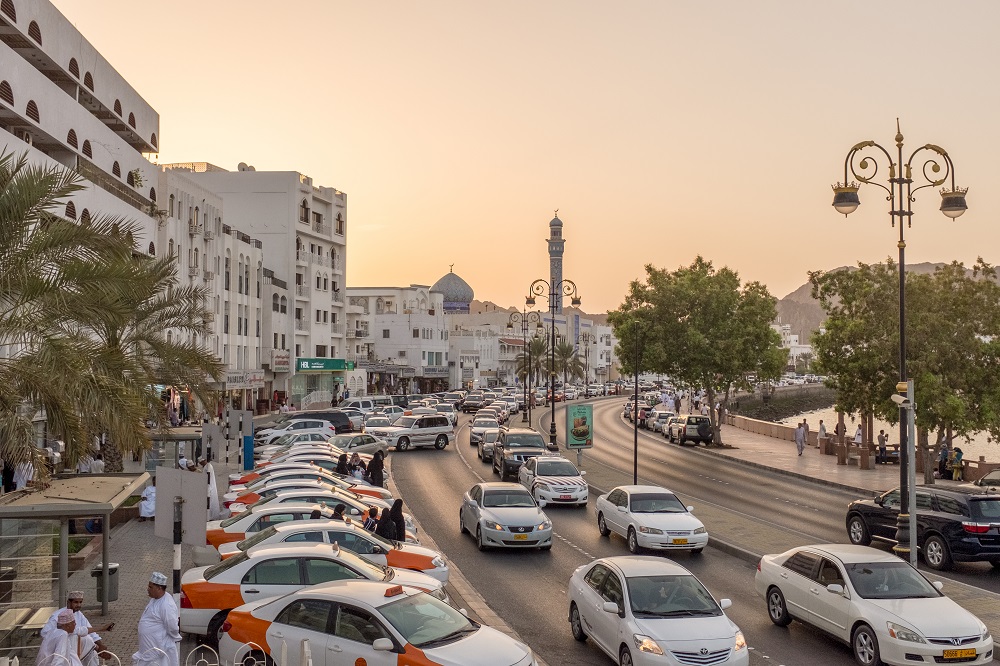DUBAI, United Arab Emirates – More than 26 million new light vehicles will enter the Middle East vehicle parc between now and 2023, and that could speed the shift to higher quality lubricants in the region, an additive supplier predicts.
The high disposable income of countries around the Middle East Gulf suggests many of the vehicles will feature the latest technology, such as direct injection gasoline engines, turbo-chargers and particulate filters with complex lubrication demands.

Photo: Glen Berlin/Shutterstock
Cars move past parked taxis at the corniche at Muttrah in Muscat, Oman. More than 26 million new light vehicles are projected to enter the Middle East vehicle parc between now and 2023, which could speed a shift to higher quality lubricants in the region.
But the regions unique combination of high ambient temperatures, dusty conditions and consumer preference for short oil drain intervals has slowed the take-up of higher specification lubricants commonplace in other automotive markets. Old habits die hard, and according to some analysts, the regions varied approach to vehicular emissions standards may mean that widespread adoption of more costly top-tier lubricants might yet be some ways off. Leading Gulf economies, such as the United Arab Emirates, conform to Euro 5, but Oman and Qatar still only mandate the equivalent of Euro 2.
According to Stefan Mueller, associate director, research and analysis at IHS Markit, improving lubricant standards will be far from uniform, at least in the short term. Big cities are also the biggest markets for cars in the Middle East, and in those it will be possible to supply and use the latest generation of lubricants, but rural areas are quite different; most cars are older, and their owners often use cheap garages or make oil changes themselves.
Nonetheless, increasingly stringent emission regulations in the European Union and the United States are forcing original equipment manufacturers to push the technology envelope in response to demands for better fuel economy. When technology meets legislation, better performing lubricants often emerge as a fix for complex lubrication problems. Kailash Sawant, Lubrizols regional business manager, engine oils for India and Middle East, believes the regions slow and fragmented approach to emissions standards has the potential to accelerate, swept along by the force of increasing regulation.
Speaking at the Base Oil and Lubes Conference organized by Conference Connection, he said global OEM platforms, newer vehicles and changes in fuel quality will change market dynamics in favor of higher lubricant specifications, in line with global trends. Or will it? Saudi Arabia, the Gulfs largest automotive market, only recently mandated API CH-4 as the minimum specification for commercial diesel vehicles. Turkey adopted Euro V in 2012, requiring the use of ultra-low-sulfur diesel.
Still, Sawant argued that regulation will not necessarily advance in small increments, pointing to the scaling-up of Bharat emission standards in India. The biggest evolutionary change will be when Bharat stage IV leaps to BS VI, and that is how quick legislation is moving. Major economies, including China, which has introduced phase III fuel economy legislation, also exert a powerful influence over the market that others may have to follow, he adds. Even so, other drivers also redefine engine technology. Growing calls by consumers for cost savings have led to a more complex combination of vehicle hardware technologies.
The gamut of after-treatment devices such as exhaust gas recirculation, diesel particulate filters and selective catalytic reduction require increased engine pressure and temperatures, posing a major technical challenge for lubricant performance. The world is moving from CH-4 to CI-4, to CI-4 Plus, and then it is soon going to be CK-4, Sawant said. The Middle East Gulf is greatly influenced by the European heavy duty market, and Europe is rapidly moving to lighter viscosity grades, away from 15W-40 grades. He said around 80 percent of heavy-duty vehicles in the region are of European origin, and more sophisticated hardware will impact engine oils, which will alter the quality of lubricants used.
By 2025, Sawant estimated, 15W-40 grades in Europe will be around 31 percent of the market, down from 57 percent in 2016. Meanwhile, 10W-XX and 5W-30 oils will comprise approximately 33 percent and 25 percent, respectively, with the use of low high temperature high shear oils, growing steadily. These market trends will rub off on lubricant usage in the Middle East Gulf, ramping up quality in the process, he asserted.
The passenger car landscape has evolved dramatically in recent years, particularly in terms of power output, torque and fuel economy. Back in 2003, power for a 1,781 cubic centimeter port fuel injected engine was around 74 kilowatts. Today, a comparable models engine is 132 kilowatts, with more efficient fuel economy. Sawant predicted that increasing numbers of vehicles in the region will have turbocharged gasoline direct injection engines, and that rules out the use of lower-tier, traditional API categories still widespread in the region.
Turbocharged gasoline direct injection engines place a lot more stress on the lubricant, and using a lower API lubricant grade can cause catastrophic engine failure. TGDI engines require advanced chemistry and base oil technology, Sawant told delegates.
Advances in lubricant technology are coming thick and fast. A number of global lubricant brands such as Shell, Total and PetroChina have already launched API SN Plus, a new API category supplement.
